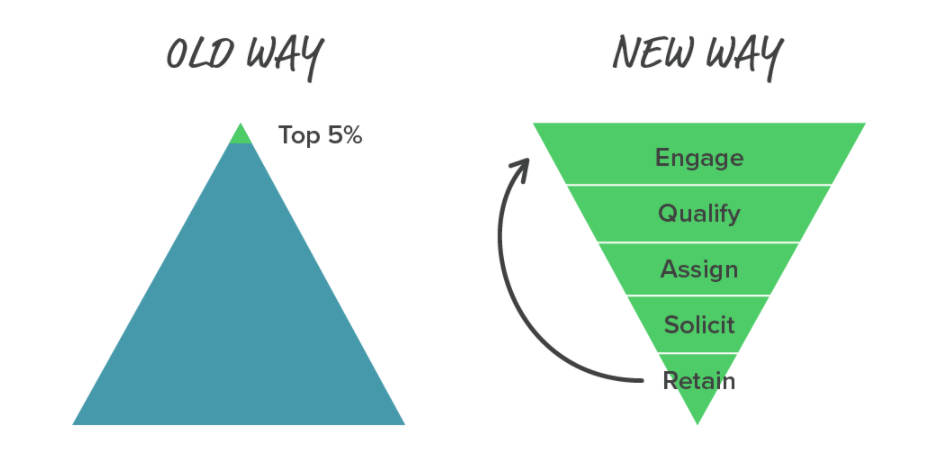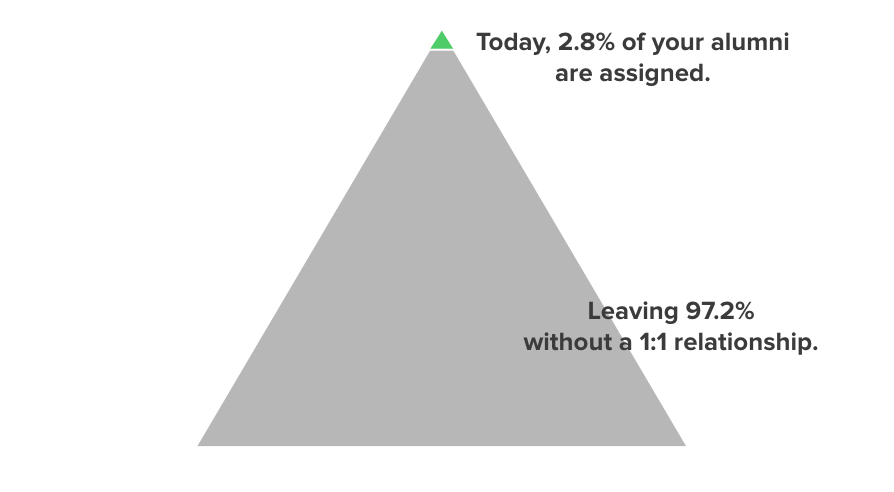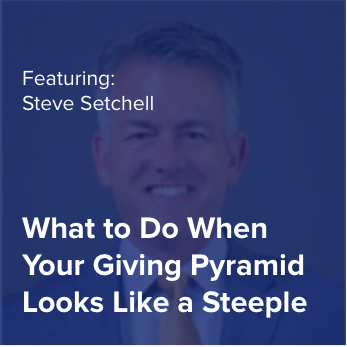Recently, we sat down with Steve Setchell, Vice President for Development and Alumni Relations at Whitman College, a small, private, liberal arts university in Walla Walla, Washington. Steve started at Whitman in November 2019, after 20 years at his alma mater, DePauw University.
After a tumultuous first year at Whitman (thanks, COVID), Steve is focused on building out Whitman’s giving pyramid.

Similar to many institutions, they’ve depended on a small proportion of donors for the majority of dollars coming in. Steve observed: “Our giving pyramid more closely resembles a church steeple than a pyramid. We need to build out — not only the base, but the middle as well — with new prospects who are coming of age as potential major gift donors. We’ve relied on very generous stalwart donors through the decades. Some of those individuals are aging out of our donor base. So the challenge is replacing them.”

Looking at institutions across the EverTrue platform, only about 2.8% of all constituents are assigned. And more than half of those assigned constituents didn’t even get a visit last year. At best we, as an industry, are reaching 1.5% of our constituents in a face-to-face or virtual meeting. Very steeple-like.
This has to change. How can we double or triple the number of assigned prospects and truly nurture and engage them? We need to leverage technology to make this happen at scale and provide the kind of experience our donors truly deserve.
Using technology to indicate capacity, engagement, and donor interests will enable our shops to provide a first-class donor experience to more than just the top 1.5% of donors.
So… How do we get started?
- Find new major gift prospects
It’s time to find the engaged, high capacity constituents sitting in your database with no 1:1 relationship with your institution. Use EverTrue to access new sources of information, set up automatic alerts for highly engaged unassigned prospects, build lists by region or donor interest, and use keyword searches of contact reports.
By starting with a focus on key priorities (and the right technology) Steve’s team can qualify prospects that might be interested in supporting these initiatives based on their previous interactions with the university. In FY21, Whitman is focused on raising funds for residential life, athletics, endowed professorships, student scholarships, the Office of Religious and Spiritual Life, and student internships.
Chances are high that your constituents have already told you what they’re excited about supporting. Whether it’s through interacting with social media posts on a certain topic, small but regular donations, event attendance, or other indicators, it’s on us to learn what our donors care about and solicit accordingly. It’s something the team at George Washington University has done effectively by identifying hundreds of new prospects and generating $6MM in gift pipeline for hard-to-fund projects like these.
Hear from GWU's Anne Dean about how her team has identified hundreds of new prospects for traditionally hard-to-fund initiatives.
There are untouched constituents in your database that are raising their hands and telling you what their priorities are. Let’s find them.
- Focus on qualification
A global pandemic might be a tough time to solicit gifts from new donors. (Not all donors, though! Many alumni and parents are more eager to support student relief efforts than ever.) Instead of going in cold with a solicitation, many shops (Whitman included) are using this as an opportunity to focus on qualification visits and expanding their planned giving pipeline.
Set strong goals for gift officers to have open calls with pre-qualified constituents. Ask about their relationship with the university and their philanthropic priorities. This is a great opportunity to learn more about your constituent base while building relationships and future pipeline opportunities.
- Build constituents’ relationships with the institution
Speaking of building relationships, donor relations needs to be a focus more than ever. Now is a great time to make sure all of your donors know how much you appreciate them. For example, the University of Wisconsin Foundation took the time to send every single donor a personalized video thanking them for their gift.
John Grice and Aimee Furrie of the University of Wisconsin Foundation share how they're making annual giving personal.
Sending 35,000 ThankViews is an incredible way to thank donors, but what about non-donors? (Or, as we like to call them, not-yet donors?) Without homecoming, in-person reunions, and face-to-face meetings, it’s easy to fall off the radar of potential donors. We’ve compiled some relationship-building ideas here. But it’s also a great opportunity to connect with more constituents than ever before as we work with fewer geographic and time restrictions.
Steve’s team at Whitman has been focused on digital engagement with constituents while also making the university president and senior leadership more accessible. Alumni, parents, and friends that may not have had the opportunity to connect with senior leadership are able to feel more connected to the university than ever. A short Zoom call or virtual meeting can lead to stronger, more personal relationships with donors. And, at its core, that’s what advancement is all about.
